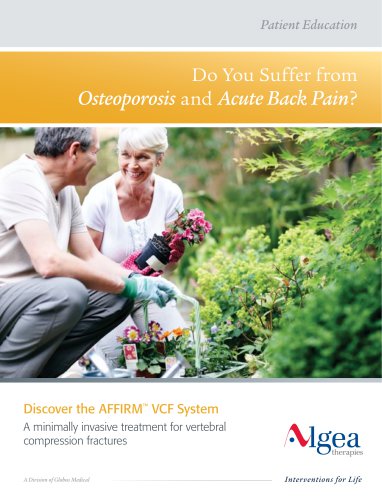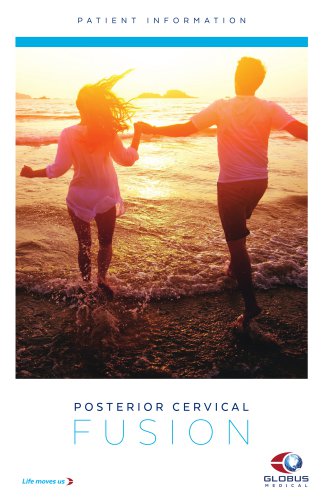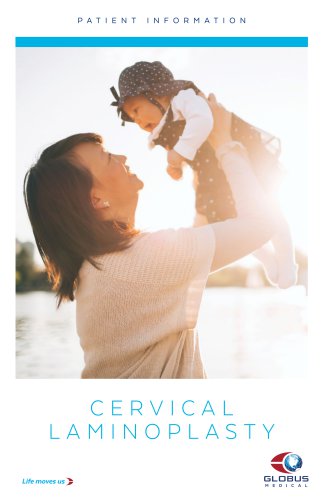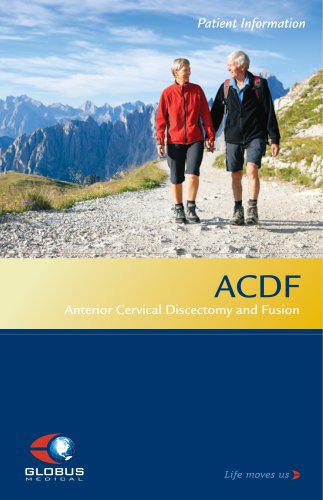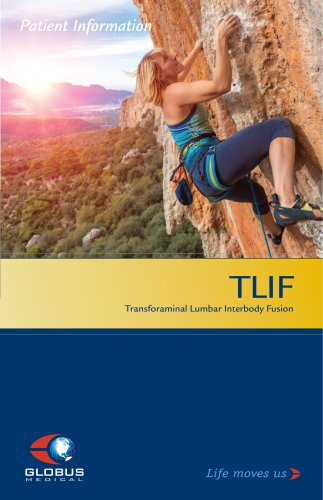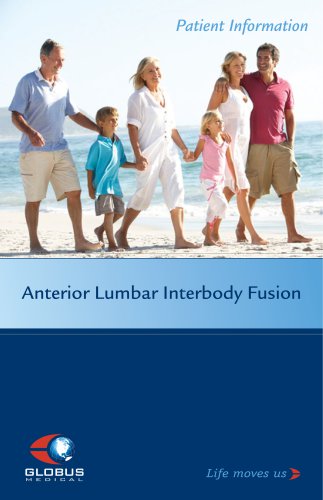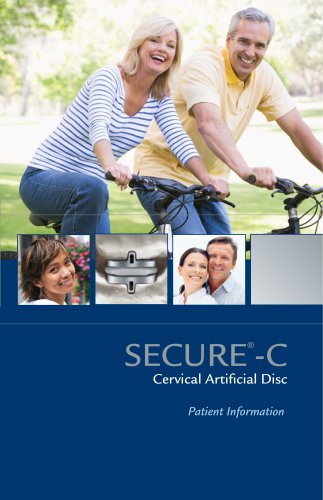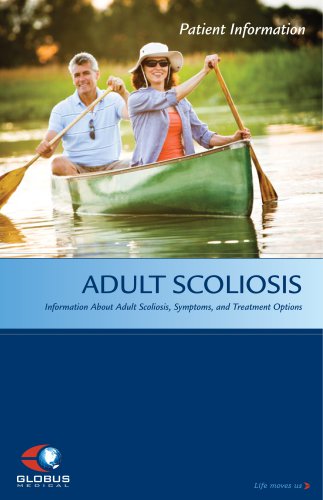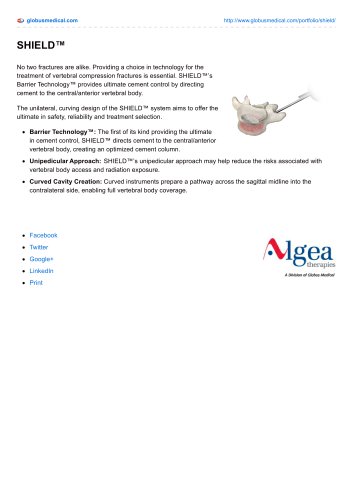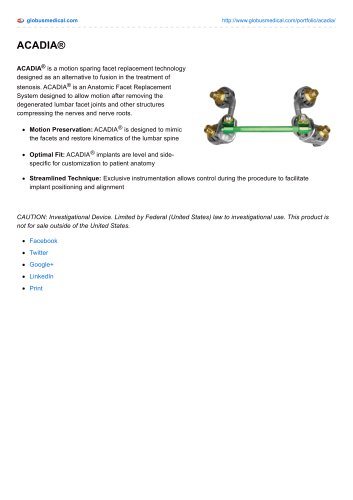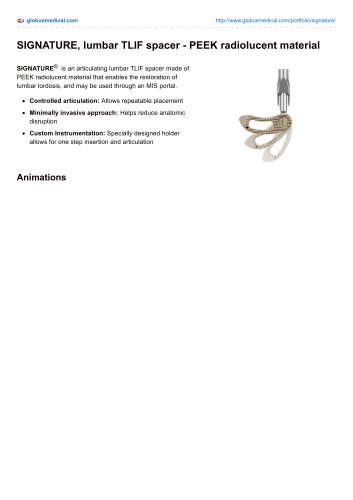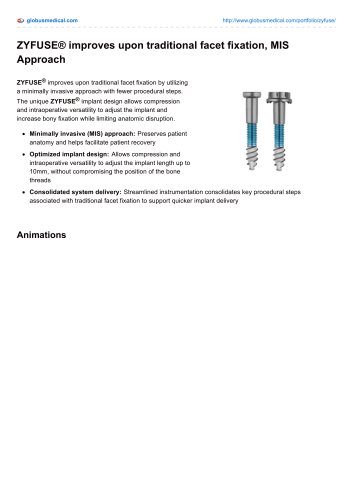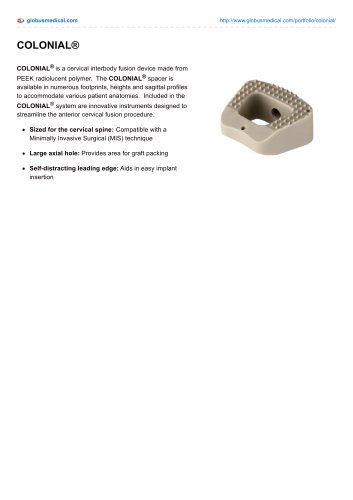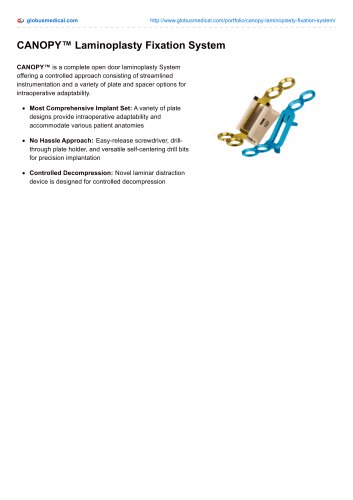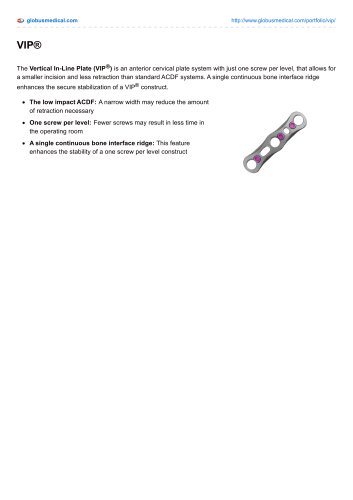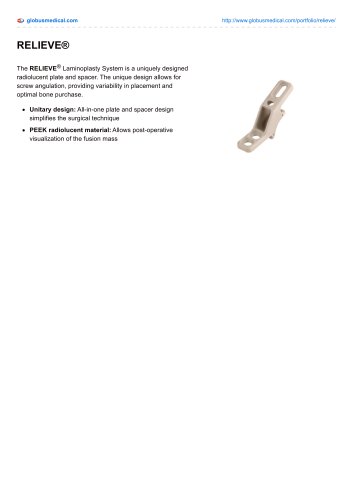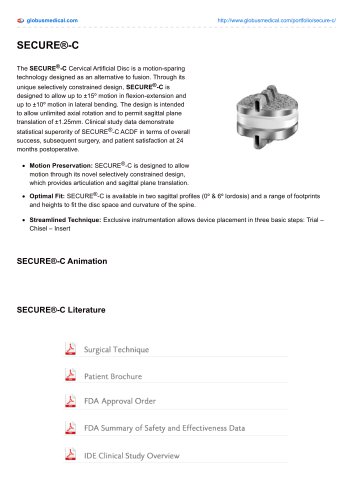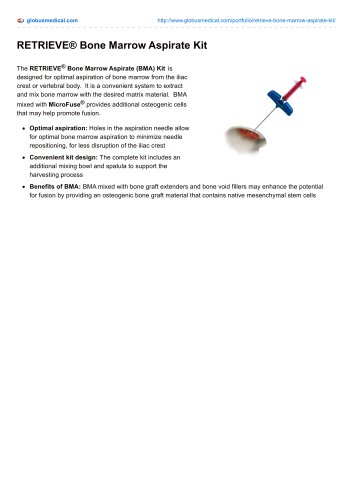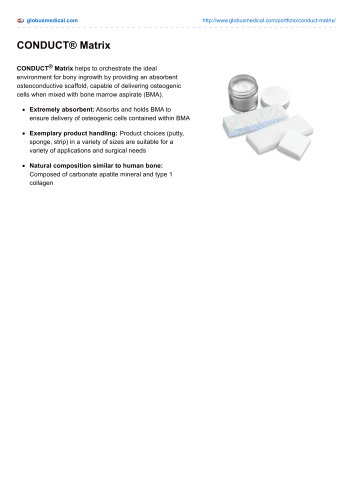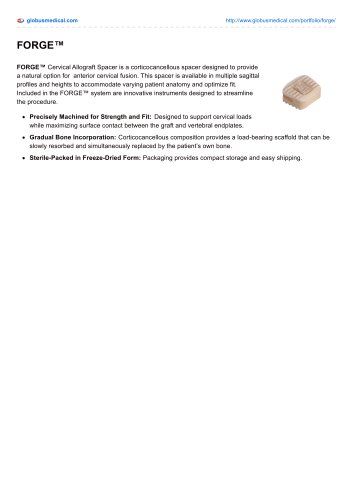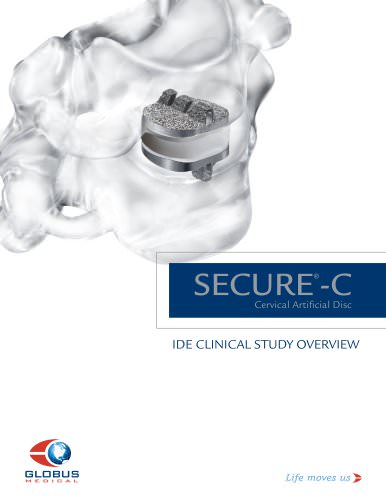
Catalog excerpts

Patient Education \lgea therapies Discover the AFFIRM™ VCF System A minimally invasive treatment for vertebral compression fractures A Division of Globus Medical Interventions for Life
Open the catalog to page 1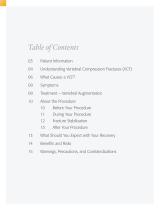
Table of Contents 03 Patient Information 04 Understanding Vertebral Compression Fractures (VCF) 09 Symptoms 09 Treatment - Vertebral Augmentation 10 About the Procedure 10 Before Your Procedure 11 During Your Procedure 13 After Your Procedure 13 What Should You Expect with Your Recovery 14 Benefits and Risks 15 Warnings, Precautions, and Contraindications
Open the catalog to page 2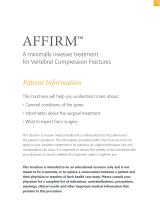
AFFIRM™ A minimally invasive treatment for Vertebral Compression Fractures Patient Information This brochure will help you understand more about: • General conditions of the spine • Information about the surgical treatment • What to expect from surgery The decision to receive medical treatment is individualized to the patient and the patient’s symptoms. The information presented within this brochure may not apply to your condition, treatment or its outcome, as surgical techniques vary and complications can occur. It is important to discuss the viability of this procedure with your physician...
Open the catalog to page 3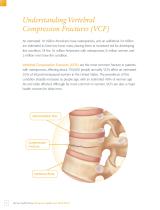
Understanding Vertebral Compression Fractures (VCF) A n estimated 10 million Americans have osteoporosis, and an additional 34 million are estimated to have low bone mass, placing them at increased risk for developing this condition. Of the 10 million Americans with osteoporosis, 8 million women and 2 million men have the condition. V ertebral Compression Fractures (VCFs) are the most common fracture in patients with osteoporosis, affecting about 750,000 people annually. VCFs affect an estimated 25% of all postmenopausal women in the United States. The prevalence of this condition steadily...
Open the catalog to page 4
VCFs have a substantial and negative impact on the quality of life and day-today functioning of those afflicted. Short-term and long-term pain in the elderly is commonly attributed to vertebral compression fractures, which may lead to further health decline. Because there is a substantial risk of subsequent fractures of all types in people who have had a vertebral compression fracture, it is important that VCFs are diagnosed and treated early. Vertebral Compression Fractures are common, especially in older adults. VCFs are primarily caused by osteoporosis, and range from mild to severe....
Open the catalog to page 5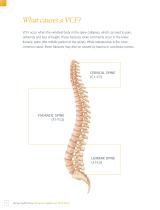
What causes a VCF? VCFs occur when the vertebral body in the spine collapses, which can lead to pain, deformity and loss of height. These fractures more commonly occur in the lower thoracic spine (the middle portion of the spine). While osteoporosis is the most common cause, these fractures may also be caused by trauma or cancerous tumors. Do You Suffer from Osteoporosis and Acute Back Pain?
Open the catalog to page 6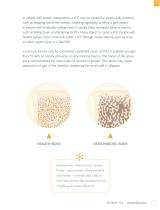
In people with severe osteoporosis, a VCF may be caused by simple daily activities, such as stepping out of the shower, sneezing vigorously or lifting a light object. In people with moderate osteoporosis, it usually takes increased force or trauma, such as falling down or attempting to lift a heavy object to cause a VCF. People with healthy spines most commonly suffer a VCF through severe trauma, such as a car accident, sports injury or a hard fall. Cancerous tumors may be considered a potential cause of VCFs in patients younger than 55 with no history of trauma or only minimal trauma. The...
Open the catalog to page 7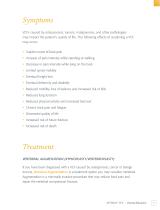
VCFs caused by osteoporosis, tumors, malignancies, and other pathologies may impact the patient's quality of life. The following effects of sustaining a VCF may occur: • Sudden onset of back pain • Increase of pain intensity while standing or walking • Decrease in pain intensity while lying on the back • Limited spinal mobility • Eventual height loss • Eventual deformity and disability • Reduced mobility, loss of balance and increased risk of falls • Reduced lung function • Reduced physical activity and increased bed rest • Chronic back pain and fatigue • Decreased quality of life •...
Open the catalog to page 9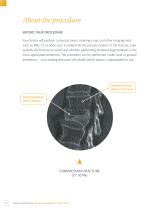
About the procedure before your procedure Your doctor will perform a physical exam, ordering x-rays and other imaging tests such as MRI, CT or bone scan to determine the precise location of the fracture, how recently the fracture occurred and whether performing Vertebral Augmentation is the most appropriate treatment. The procedure can be performed under local or general anesthesia – your treating physician will decide which option is appropriate for you. Vertebral Body without Fracture Vertebral Body with Fracture Compression Fracture (CT Scan) Do You Suffer from Osteoporosis and Acute...
Open the catalog to page 10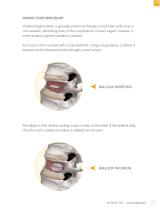
during your procedure Vertebral Augmentation is generally performed through a small tube under local or mild sedation, eliminating many of the complications of open surgery. However, in some situations, general sedation is advised. Your back is then numbed with a local anesthetic. Using x-ray guidance, a balloon is inserted into the fractured vertebra though a small incision. balloon insertion The balloon is then inflated, creating a void, or cavity, on the inside of the vertebral body. Once the void is created, the balloon is deflated and removed. balloon inflation AFFIRM™ VCF | Patient...
Open the catalog to page 11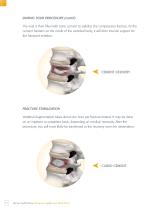
during your procedure (cont’d) The void is then filled with bone cement to stabilize the compression fracture. As the cement hardens on the inside of the vertebral body, it will form internal support for the fractured vertebra. cement delivery fracture stabilization Vertebral Augmentation takes about one hour per fracture treated. It may be done on an inpatient or outpatient basis, depending on medical necessity. After the procedure, you will most likely be transferred to the recovery room for observation. cured cement Do You Suffer from Osteoporosis and Acute Back Pain?
Open the catalog to page 12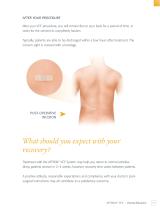
after your procedure After your VCF procedure, you will remain flat on your back for a period of time, in order for the cement to completely harden. Typically, patients are able to be discharged within a few hours after treatment. The incision sight is covered with a bandage. Post-operative incision What should you expect with your recovery? Treatment with the AFFIRM™ VCF System may help you return to normal activities. Many patients recover in 2–4 weeks; however, recovery time varies between patients. A positive attitude, reasonable expectations and compliance with your doctor’s...
Open the catalog to page 13All Globus Medical catalogs and technical brochures
-
Discover the SHIELD™ VCF System
20 Pages
-
POSTERIOR CERVICAL FUSION
12 Pages
-
ExcelsiusGPS
12 Pages
-
CERVICAL LAMINOPLASTY
14 Pages
-
SECURE-C®
24 Pages
-
ACDF
16 Pages
-
TLIF patient brochure
12 Pages
-
SI-LOK™
12 Pages
-
TRANSITION
12 Pages
-
complete bone graft
1 Pages
-
SP-Fix
12 Pages
-
SECURE®-C
24 Pages
-
Adolescent Idiopathic Scoliosis
16 Pages
-
ADULT SCOLIOSIS
16 Pages
-
MIS LLIF
16 Pages
-
MIS TLIF
12 Pages
-
MONUMENT
2 Pages
-
CREO AMP® Threaded
1 Pages
-
CREO MCS?
2 Pages
-
SHIELD?
1 Pages
-
ACADIA®
1 Pages
-
SIGNATURE®
1 Pages
-
SUSTAIN® & SUSTAIN®-R, Arch
1 Pages
-
TRUSS®
1 Pages
-
XPand®-R
1 Pages
-
ZYFUSE®
1 Pages
-
COLONIAL®
1 Pages
-
VIP®
1 Pages
-
PROVIDENCE?
1 Pages
-
RELIEVE®
1 Pages
-
ASSURE®
1 Pages
-
SECURE®-C
2 Pages
-
COALITION®
1 Pages
-
CAPITOL?
1 Pages
-
LATIS
3 Pages
-
CONDUCT® Matrix
1 Pages
-
FORGE?
1 Pages
-
SECURE®-C technical overview
12 Pages

